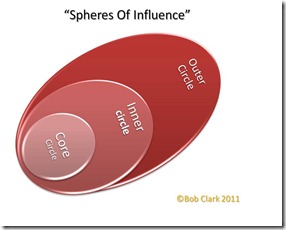The use of established consumer marketing techniques can be useful in building a personal brand. Brand management of consumer goods focuses on connecting with a consumer and clearly establishing a relationship in order to stimulate some action. Possibly the least used, yet most important marketing technique to transfer to personal branding, is determining who is your Target Market.
Sphere Of Influence
“Target market,” while used daily in consumer products, is too harsh a term in the world of personal branding and relationship building as it suggests a singular,rather cold intent to sell something. A better term might be Sphere of Influence, or group in which you interact in order to influence. Another popular term is “Tribe”, but that term leaves me with the feeling of residence and community rather than influence. Your sphere of influence is really those with which you regularly interact in a positive and meaningful way, establishing credibility, conversation and eventually action.
Some Examples –
- You are a photographer and would like to share your work, perspective, and expertise. That sphere of influence would include friends, other photographers, and perhaps people who appreciate art or the subjects that you like to photograph (desert landscapes among people who live in the Southwest), etc. You ultimately want to influence this group to communicate with you, get to know you and eventually purchase your photos or hire you for some work.
- You are a small business retail owner in town trying to grow your business. Here you may define your sphere of influence as people who live and work in your community, local community organizations, consumers in a regional vicinity, as well as friends.
- You are an executive of a larger organization desiring to be more known outside corporate walls. Your sphere of influence would be personal and business contacts within the community, peer institutions, executive recruiters, previous employ(ees)/(ers), social networks, and trade associations.
- Core – Your immediate family, spouse, work team, and your boss. You interact with individuals from this group many times each day. This can also include an inner core of people with whom you have partnered on a given assignment that are centered with you on your goals
- Inner Circle – These are your work acquaintances, personal friends, vendors, past colleagues, other departments. These are often untapped resources and can easily be called upon. This is a wide group that knows you.
- Outer Circle – The outer circle is made up of people you don’t see — community members you may or may not know but could be introduced to – sometimes made up of bloggers, politicians, – anyone you could approach but probably have not. This is fertile ground for cultivation, but not your first priority.
The point is to recognize that your sphere of influence should be carefully defined, developed from the center outward. Precious time can be wasted in activities relate to outer spheres, which are much harder to develop while closer in networks lay undeveloped. The tools of social networking – Facebook, blogging, tweeting, etc, can be a drug of sorts, draining time if not directed toward a clear definition of your goals of building your community. But, having defined these groups, you can begin to gain insight into their interests and then establish the effective messaging necessary to convey your brand identity.



I really enjoyed this post. It resonated for me since I used to view my network as an archery target.
Thank you for giving me a better insight into this whole concept of personal branding. I decided to take on Entrepreneurship and I been struggling with personal branding. I never thought of it as spheres of influence. Most everyone I talk to have a different answer or explanation. I know my target market – Service provider, but not quite sure how to connect personal brand in establishing a credibility conversation. I would love to get your response
Hi Diane. Best of luck with your entrepreneurial venture. Your inner core and inner circle are the best place to start in letting others know what you are up to. Explain to them your service and the ONE simple benefit your service brings. Remember, they will naturally be spreading the word and trying to explain this to someone else so keep it simple and benefit focused.